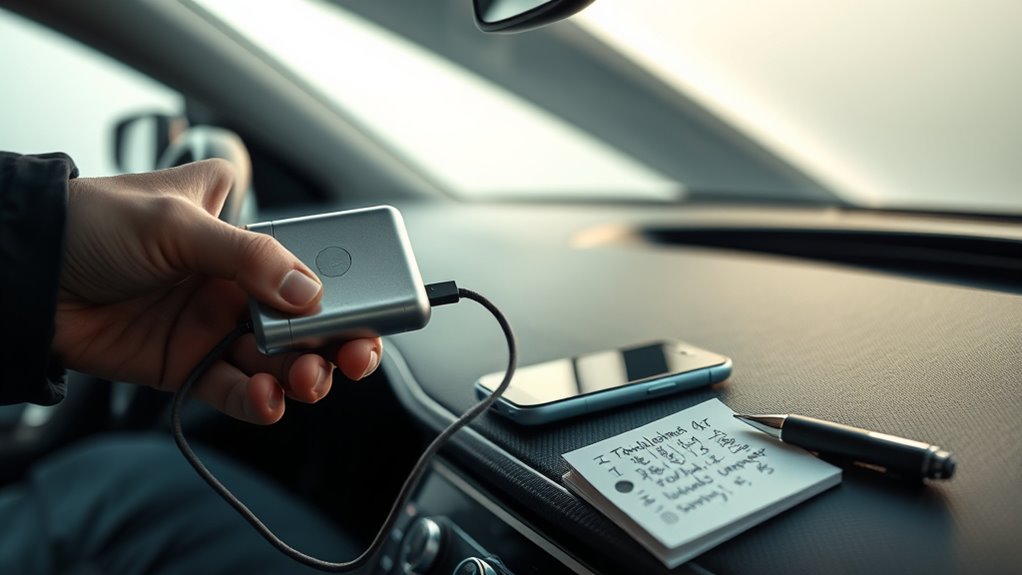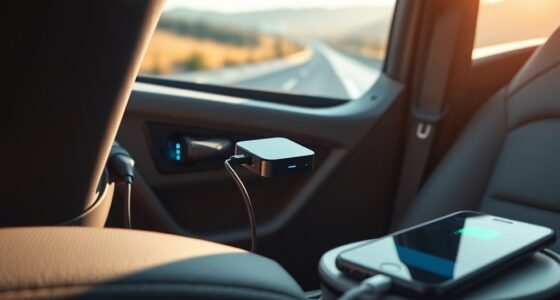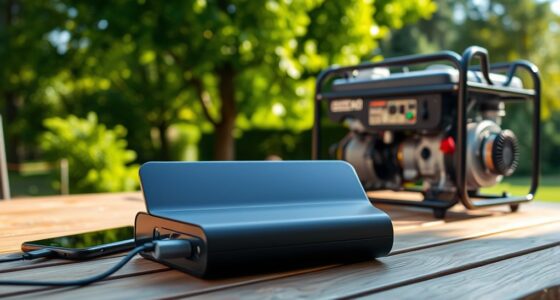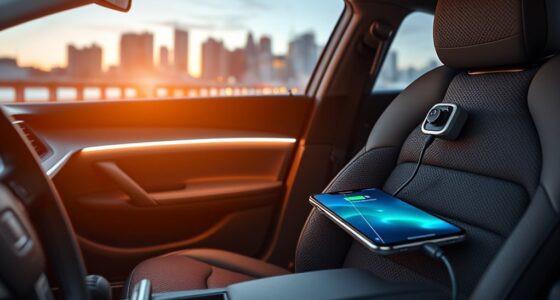To troubleshoot car device charging effectively, start by inspecting your power outlets and fuses for blockages or damage. Check your charger and cables for visible wear or corrosion, and make certain they’re compatible with your device’s power needs. Verify wiring connections and try different outlets if necessary. Proper placement to prevent overheating, along with regular maintenance, makes a big difference. Continue exploring these steps to help keep your devices charging smoothly every time.
Key Takeaways
- Check and replace blown fuses, ensure power outlets are clean and functioning properly.
- Inspect charging cables and connectors for damage, dirt, or corrosion regularly.
- Position devices in well-ventilated, cool areas away from heat sources to prevent overheating.
- Use compatible, high-quality chargers and cables matching device specifications for reliable charging.
- Conduct routine maintenance on wiring, ports, and devices to prevent faults and ensure optimal performance.
Checking Your Car’s Power Outlet and Fuses

Before troubleshooting your car charging device, you should first check the power outlet and fuses. Start with the cigarette lighter socket; ensure nothing is blocking the connection and that it’s clean. If your device still doesn’t power up, turn to your fuse box. Locate the fuse related to the cigarette lighter or power outlet—typically marked clearly. Use the fuse diagram usually found on the fuse box cover to identify the correct fuse. Remove the fuse with a fuse puller or tweezers and inspect it closely. If the fuse appears burnt or broken, replace it with one of the same amperage. This simple step often solves power issues, ensuring your car’s power outlet is ready for charging your devices. Additionally, confirming that your car’s power outlets are functioning properly can prevent further issues during your device charging.
Inspecting and Testing Your Car Charger
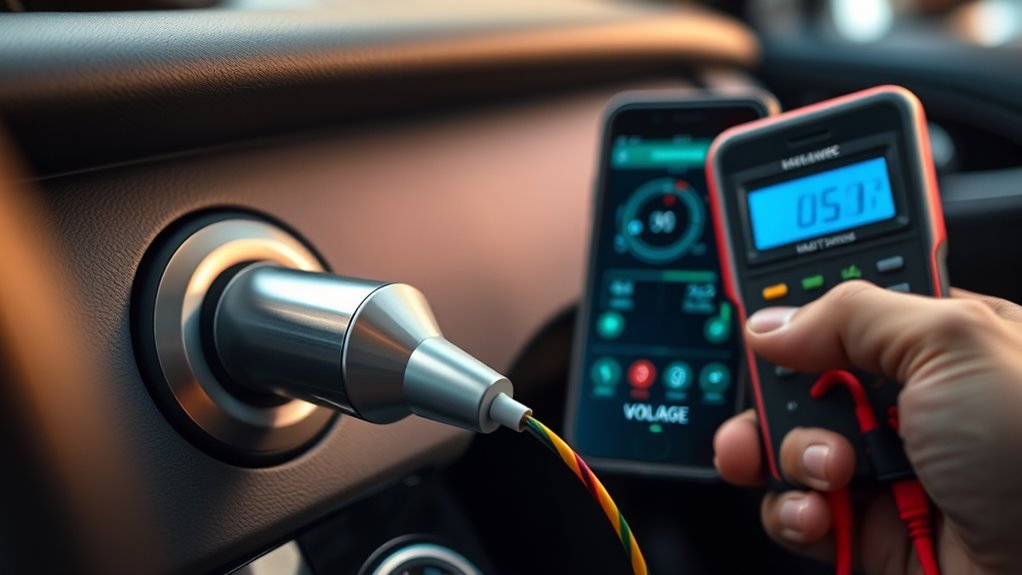
To verify your car charger is functioning properly, start by inspecting it for visible damage or debris. Check the charging port and cable for cracks, corrosion, or dirt that could interfere with connection. If your charger supports wireless charging, ensure the pad is clean and free of obstructions. Proper cable management is vital; untangle any knots and secure cables to prevent strain that could cause internal damage. Test the charger by plugging it into the power outlet and connecting your device or wireless charging pad. Observe if the device begins charging or if the wireless charging indicator lights up. If the charger isn’t working, try a different outlet or cable. Regular inspection helps catch issues early and guarantees reliable performance. Additionally, reviewing Glycolic Acid Benefits for Skin can provide insight into skin care that complements your overall health routines.
Verifying Device Compatibility and Charging Requirements
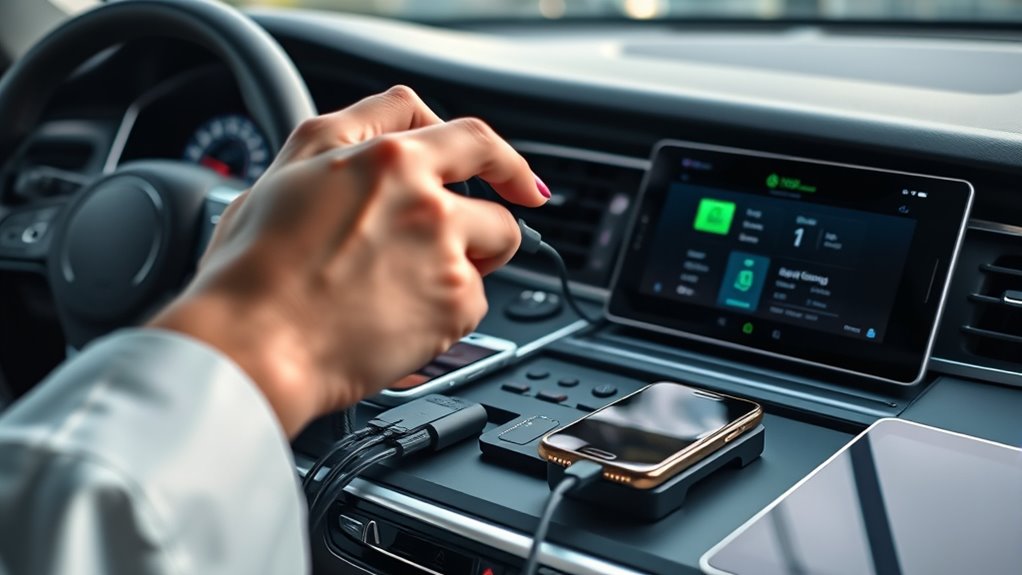
Ensuring your device is compatible with your car charging system is essential for safe and efficient charging. Check your device’s firmware updates, as outdated firmware can cause charging issues or incompatibility. Verify the charging requirements specified by your device manufacturer, including voltage and current ratings, to match your car charger’s output. Additionally, pay attention to cable quality; low-quality or damaged cables can hinder charging performance or even damage your device. Use cables that meet safety standards and are designed for your device’s power needs. Confirming these factors helps prevent potential issues and guarantees your device charges properly without risking harm. Staying informed about data privacy challenges is also important when using connected devices and charging systems. Taking these simple steps guarantees a smoother, safer charging experience on the go.
Troubleshooting Wiring and Connection Issues
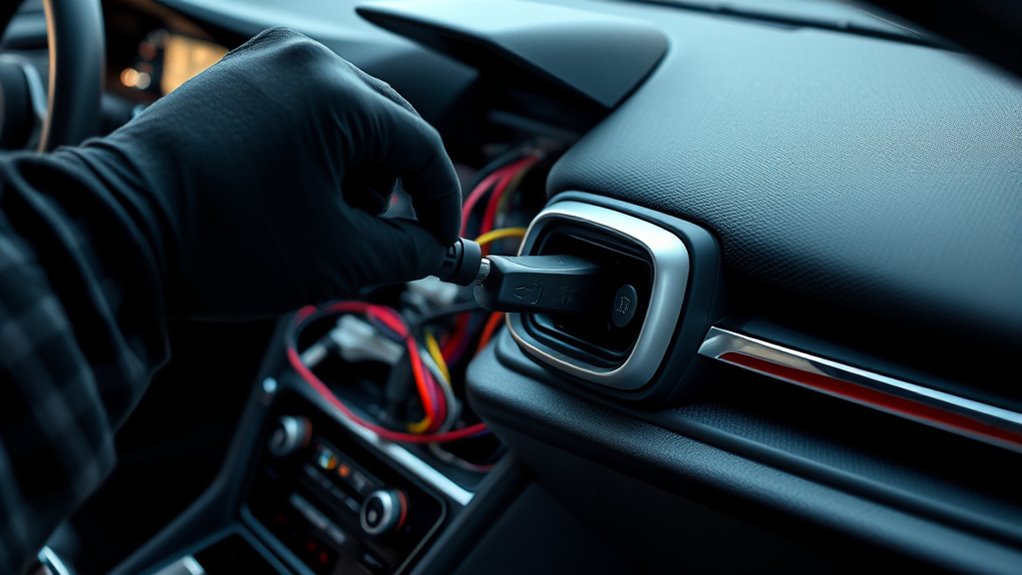
If your device still isn’t charging properly after verifying compatibility and requirements, wiring and connection issues might be the cause. Start by inspecting your wiring connections, ensuring they’re secure and free of damage. Use circuit testing tools to check for continuity and identify broken or faulty wiring. Refer to wiring diagrams specific to your charger or vehicle to verify correct wiring routes and connections. Look for loose terminals, corrosion, or exposed wires that could disrupt power flow. Confirm that all connections are tight and properly insulated. If you find any issues during circuit testing or wiring diagram comparison, repair or replace damaged wires before testing again. Proper wiring and secure connections are essential for a reliable charging experience. Additionally, inspecting for faulty connections can help identify intermittent issues that may not be immediately visible.
Using Alternative Charging Methods and Devices
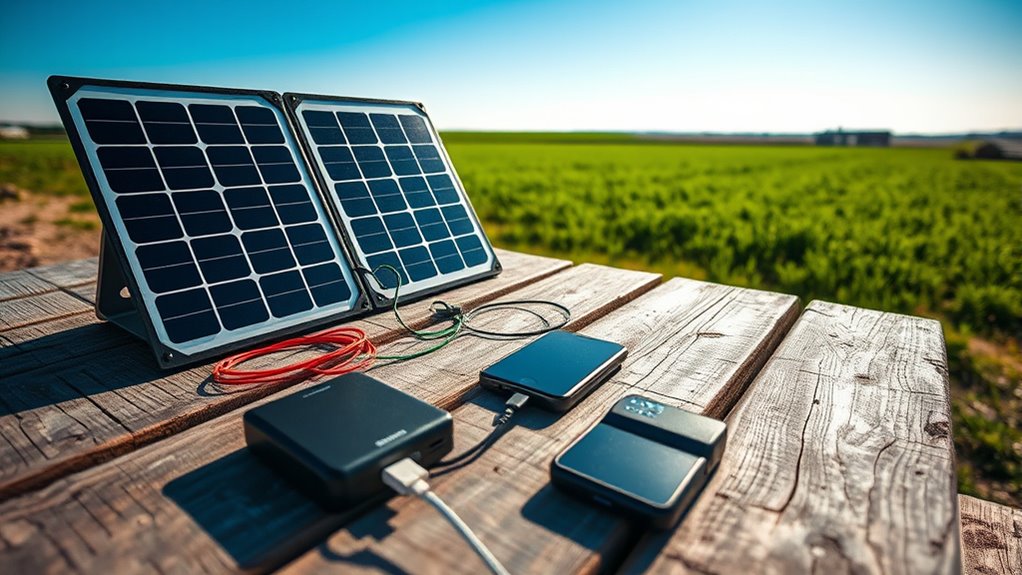
If your car charger isn’t working, consider using alternative methods like portable power banks or solar charging options. These devices can keep your devices powered up when traditional charging fails. Exploring these options guarantees you’re prepared for different situations on the road. Additionally, understanding how to safely handle juice extraction from oranges can ensure you have fresh, nutrient-rich juice to keep your energy levels up during long trips.
Portable Power Banks
Portable power banks offer a convenient way to keep your devices charged on the go, especially when traditional power sources aren’t available. They come in various sizes and capacities, allowing you to charge smartphones, tablets, or even small laptops. Some models support wireless charging, eliminating the need for cables, while others can be paired with portable solar panels for eco-friendly recharging. These options are perfect during outdoor adventures or long drives. When choosing a power bank, consider capacity, charging speed, and compatibility with your devices. Keep a few in your car for emergencies. Here’s a quick comparison:
| Feature | Benefit |
|---|---|
| Wireless Charging | No cables needed, quick top-up |
| Portable Solar Panels | Recharges power bank using sunlight |
| Capacity | Longer device usage |
| Size & Portability | Fits easily in glove compartment |
| Compatibility | Supports multiple devices |
Additionally, selecting a power bank with an efficient energy conversion process can help maximize the charge your devices receive, reducing waste and extending usage time.
Solar Charging Options
When traditional power sources are unavailable, solar charging options provide an eco-friendly and independent way to keep your devices powered. A portable solar panel captures sunlight and converts it into electricity, making it ideal for outdoor adventures. To maximize efficiency, connect the solar panel to a battery storage unit, which stores excess power for later use. This setup ensures your devices stay charged even on cloudy days or after sunset. Look for solar panels with high wattage and durability, suitable for your environment. Battery storage allows you to harness solar energy steadily, providing a reliable backup. Combining these tools offers a sustainable, portable solution that reduces reliance on grid power and keeps your devices ready whenever you need them.
Ensuring Proper Placement and Avoiding Overheating
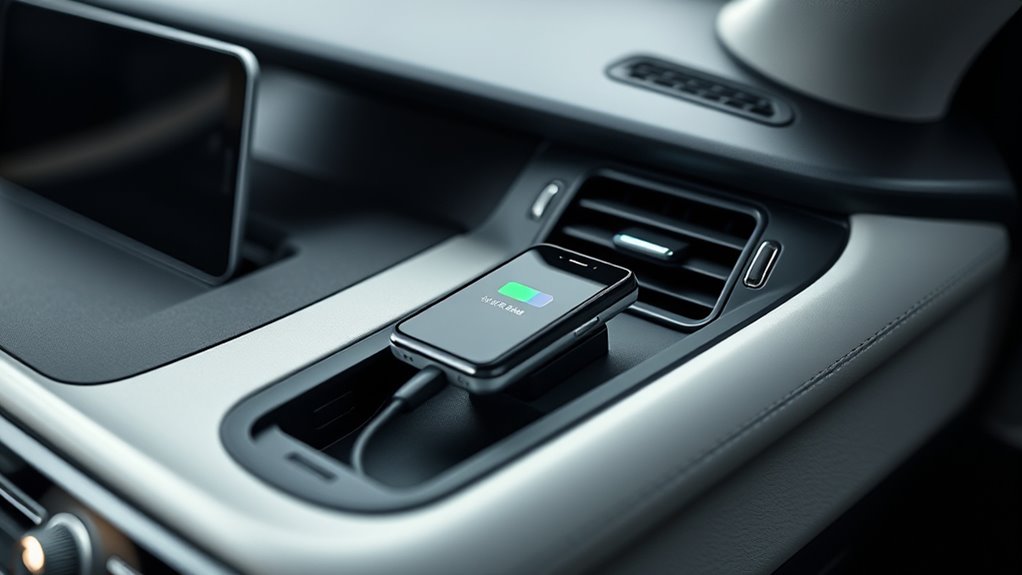
To keep your car charging device working safely, you need to choose the right location. Make sure it’s in an area with good airflow to prevent overheating. Proper ventilation tips can help you avoid damage and keep your device running smoothly. Incorporating personalized work environments can further enhance safety by ensuring your setup is tailored to your space and needs.
Optimal Charging Location
Choosing the right spot for your car charging device is essential to guarantee safety and efficiency. Find a location with good airflow, avoiding direct sunlight or areas prone to heat buildup. Proper cable management keeps cords tidy and prevents accidental disconnections or damage. Keep cables away from hot surfaces, moving parts, or areas where they could be pinched. Adhere to charging etiquette by not overloading outlets or using damaged cables that could cause short circuits. Position your device away from clutter that could obstruct ventilation or cause accidental disconnections. Ensure the device is stable and secure, avoiding places where vibrations or bumps might loosen connections. A well-chosen spot helps prevent overheating and ensures your device charges safely and quickly. Understanding AI Bifurcation can also help you anticipate future technological changes that might influence your device’s performance and safety.
Prevent Overheating Risks
Proper placement of your car charging device is essential to prevent overheating. If the charger is exposed to direct sunlight or placed near heat sources, it can cause battery overheating and damage the charger insulation. To avoid this, follow these tips:
- Keep the charger in a shaded, cool spot inside your vehicle.
- Avoid placing it near vents or heating elements.
- Ensure good airflow around the device to prevent heat buildup.
- Regularly check for signs of overheating, such as melting or unusual smells.
- Store the device in a location that minimizes exposure to heat sources and maintains a stable temperature.
Proper Ventilation Tips
Placing your car charging device in an area with good airflow helps prevent heat buildup that can cause overheating. Proper ventilation guarantees effective air circulation, which aids in temperature control. Keep the device away from direct sunlight or enclosed spaces where heat can trap. To optimize placement, consider the following tips:
| Tip | Explanation |
|---|---|
| Avoid tight spots | Poor air circulation increases heat risk. |
| Use vents | Position near air vents for better airflow. |
| Elevate device | Prevents heat transfer from surfaces. |
| Check ambient temperature | Cooler environments reduce overheating chances. |
| Regularly clean vents | Keeps airflow unobstructed. |
Additionally, choosing a location with proper insulation can help maintain a stable temperature, reducing the likelihood of overheating.
Regular Maintenance and Preventative Checks
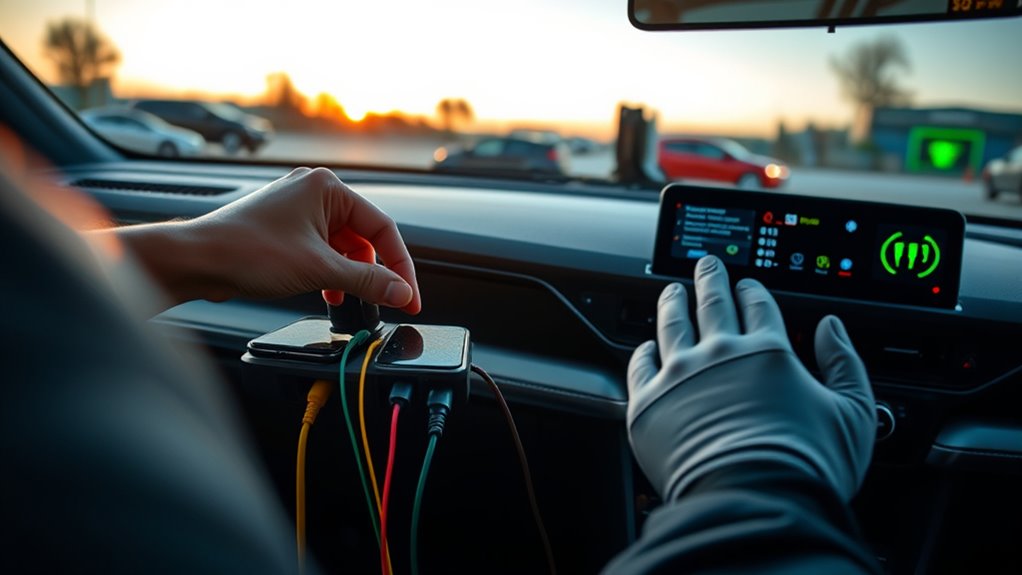
Regular maintenance and preventative checks are essential to guarantee your car charging device operates safely and efficiently. By regularly inspecting your device, you can extend its battery lifespan and ensure proper charging etiquette. To keep everything in top shape, consider these steps:
- Check for visible damage or wear on cables and connectors.
- Clean charging ports to remove dust and debris.
- Test the device periodically to confirm it charges correctly.
- Follow manufacturer guidelines for updates and calibration.
Performing these checks prevents unexpected failures and maintains peak performance. Proper maintenance helps you avoid overcharging or undercharging, protecting both your device and vehicle’s electrical system. Remember, consistent upkeep saves you time and money while ensuring your charging setup remains safe and reliable.
Frequently Asked Questions
How Do I Reset a Blown Fuse in My Car?
To reset a blown fuse in your car, first locate the fuse box, usually under the dashboard or hood. Use a fuse puller or pliers to remove the blown fuse. Check if it’s broken; if so, replace it with a fuse of the same amperage. After fuse replacement, turn on your vehicle to verify the electrical reset functions. Always double-check the fuse’s condition to prevent future electrical issues.
Can a Damaged USB Cable Cause Charging Issues?
Did you know that nearly 40% of charging issues are caused by faulty cables? A damaged USB cable can definitely be the culprit behind your charging problems. When a cable is frayed, bent, or has broken connectors, it disrupts the flow of power, leading to slow or no charging. To fix this, try replacing the USB cable with a known good one, and see if your device starts charging properly again.
What Are Signs of a Failing Car Power Outlet?
You’ll notice signs of a failing car power outlet if your cigarette lighter issues persist or if it doesn’t power your devices properly. Look out for corrosion around the outlet, which can cause poor contact or intermittent charging. Additionally, if your devices suddenly stop charging or the outlet feels loose, these are clear indicators that the power outlet might be failing and need inspection or replacement.
How Do I Determine My Device’s Maximum Charging Wattage?
To determine your device’s maximum charging wattage, check the manufacturer’s specifications usually found in the user manual or on the device itself. Look for terms like “power input” or “charging wattage” for clarity. Make sure your car charger matches your device’s compatibility needs; using a charger with insufficient wattage can slow charging or cause damage. Always choose a charger that supports your device’s maximum charging wattage for safe, efficient power delivery.
Is It Safe to Use a Portable Power Bank in My Car?
Using portable power banks in your car can be safe if you follow proper car charging safety guidelines. Make sure your power bank is compatible with your car’s voltage and current ratings, and avoid overloading the system. Always connect devices securely and don’t leave the power bank unattended while charging. By following these safety tips, you can enjoy the convenience of portable power banks without risking damage or safety hazards.
Conclusion
By following these steps, you’re steering the maze of car charging with the precision of a seasoned explorer. Keep your connections tight and your devices compatible, like keys fitting perfectly into a lock. Regular checks are your lighthouse, guiding you safely through the fog of potential issues. With patience and care, you’ll turn your car’s power outlet into a reliable river of energy, ensuring your devices stay charged and ready to serve you, no matter the journey ahead.
